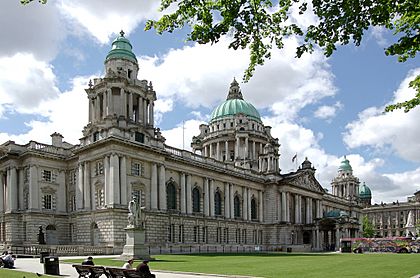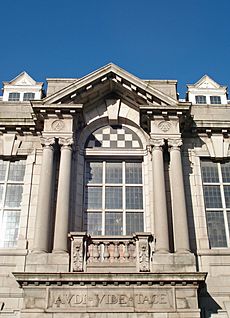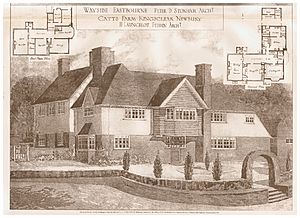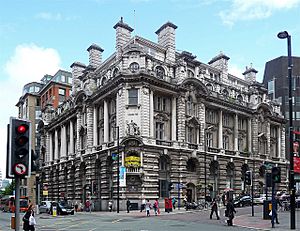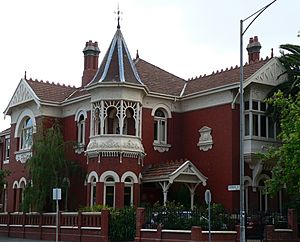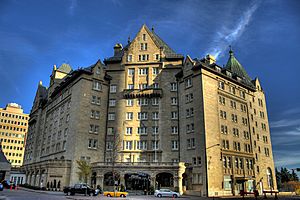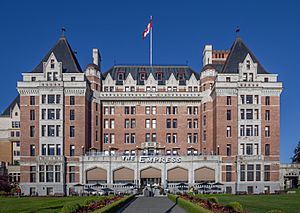Edwardian architecture facts for kids
Edwardian architecture is a cool building style that was popular in the British Empire from 1901 to 1910, during a time called the Edwardian era. Sometimes, buildings made up to 1914 are also considered part of this style. It's like a new version of an older style called Baroque.
Contents
What is Edwardian Architecture?
Edwardian buildings are usually simpler than the fancy Victorian ones that came before them. However, there's a special type called Edwardian Baroque architecture that was used for big, important buildings. These buildings are often very grand and decorative.
The Victorian Society is a group that works to protect buildings made between 1837 and 1914. This means they help look after both Victorian and Edwardian buildings.
Key Features of Edwardian Baroque
The Edwardian Baroque style got its ideas from two main places:
- French buildings from the 1700s.
- Buildings designed by Sir Christopher Wren in England during the 1600s.
Because of Sir Christopher Wren's influence, this style is sometimes called "Wrenaissance." A famous architect named Sir Edwin Lutyens used this "Grand Style" for many business buildings in the 1910s and 1920s. This time in British architecture looked back at older styles, even though a new style called Art Nouveau was also popular.
Typical details you might see in Edwardian Baroque buildings include:
- Rough Stone Look: Walls often have a rough, textured stone finish, especially near the bottom. This can make the arches over windows and doors look even bigger.
- Fancy Roofs: Many buildings have domed towers on the corners of their roofs and a taller tower in the middle. This creates an interesting shape against the sky.
- Italian Baroque Touches: You might see big, decorative keystones (the wedge-shaped stone at the top of an arch), curved pediments (triangular or curved shapes above windows), and columns that look like they have blocks attached to them.
- Columns: Rows of columns, sometimes in pairs, are common. They often follow the Ionic order, which means they have scroll-like decorations at the top. These columns and domed towers were often inspired by Wren's designs for the Royal Naval College in Greenwich.
- Some Edwardian Baroque buildings also mix in other styles, like the Dutch gables (stepped or curved roof edges) seen on Norman Shaw's Piccadilly Hotel in London.
Other common features include:
- Lighter Colours: Edwardian buildings often used lighter colours. This was partly because gas and electric lights meant people didn't worry as much about soot making walls dirty, unlike in the Victorian era.
- Simpler Patterns: Designs for things like wallpaper and curtains were less complicated than before.
- Less Clutter: There were fewer small decorations everywhere. Ornaments might be grouped together instead of spread out all over the room.
Architectural Influences
Edwardian architecture was influenced by several other building styles:
- Victorian
- Art Nouveau
- Georgian
- Arts and Crafts
- Federation
Famous Edwardian Buildings
Many impressive buildings were constructed in the Edwardian style around the world. Here are some notable examples:
United Kingdom
- Admiralty Arch, London (1912)
- Albert Hall, Manchester (1910)
- Ashton Memorial, Lancaster, by John Belcher (1909)
- Australia House, London (1918)
- Belfast City Hall, Belfast, by Brumwell Thomas (1906)
- Cardiff City Hall, Cardiff (1906)
- Central Criminal Court (Old Bailey), London (1902–07)
- County Hall, London (1922)
- Electric Cinema, London (1910)
- Government Offices Great George Street, London (1908–17)
- Laing Art Gallery, Newcastle upon Tyne (1904)
- London Road Fire and Police Station, Manchester (1906)
- Lloyds Bank on King Street, Manchester (1915)
- Manchester Victoria station, Manchester (1909)
- Marylebone station, London (1899)
- Mitchell Library, Glasgow (1906–11)
- Port of Liverpool Building, Liverpool (1903–07)
- Stockport Town Hall, Stockport, by Brumwell Thomas (1908)
- War Office, London (1906)
- Westminster Central Hall, London (1911)
Argentina
- Thompson Muebles Ltd, Buenos Aires (1914)
- Harrods - Bs.As. Ltd, Buenos Aires (1914)
- Retiro Mitre railway station, Buenos Aires (1915)
Australia
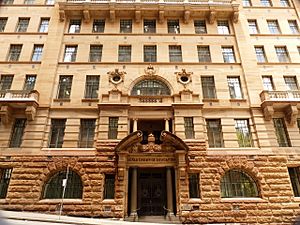
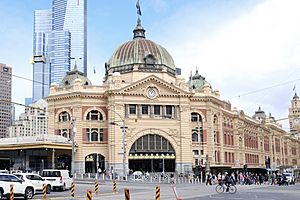
- Lands Administration Building, Brisbane (1905)
- Central Railway Station, Sydney (1906)
- Department of Education building, Sydney (1912)
- Flinders Street railway station, Melbourne (1909)
- State Library of New South Wales, Sydney (1905-1910)
- Art Gallery of New South Wales (1897-1909)
- His Majesty's Theatre, Perth (1904)
- Registrar-General's building, Sydney (1913)
Canada
- Château Laurier, Ottawa
- Dominion Building, Vancouver
- Fort Garry Hotel, Winnipeg
- Hotel Macdonald, Edmonton
- King Edward Hotel, Toronto
- Palliser Hotel, Calgary
- Sun Tower, Vancouver
- The Empress, Victoria
Hong Kong
- Main Building of The University of Hong Kong
- Ohel Leah Synagogue
- Old Supreme Court Building
India
- Ripon Building, Chennai
- Rashtrapati Bhavan, New Delhi
Ireland
Malaysia

- City Hall, George Town, Penang (1903)
- Railway station in Ipoh, Perak (1917 to 1935)
New Zealand
- Auckland Town Hall, Auckland, New Zealand
- General Post Office (former), Auckland, New Zealand
- Auckland Ferry Terminal
Singapore
- Victoria Memorial Hall (1905)
- Central Fire Station (1908)
Sri Lanka
- Royal College, Colombo
See also
- Edwardian era
- Baroque Revival architecture


